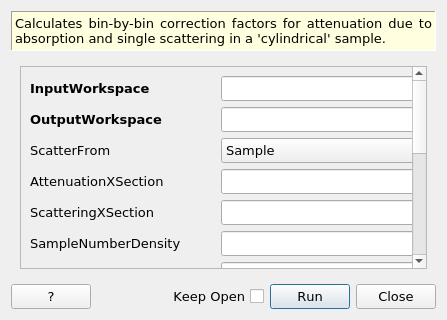\(\renewcommand\AA{\unicode{x212B}}\)
CylinderAbsorption v1¶

CylinderAbsorption dialog.¶
Summary¶
Calculates bin-by-bin correction factors for attenuation due to absorption and single scattering in a ‘cylindrical’ sample.
See Also¶
Properties¶
Name |
Direction |
Type |
Default |
Description |
|---|---|---|---|---|
InputWorkspace |
Input |
Mandatory |
The X values for the input workspace must be in units of wavelength |
|
OutputWorkspace |
Output |
Mandatory |
Output workspace name |
|
ScatterFrom |
Input |
string |
Sample |
The component to calculate the absorption for (default: Sample). Allowed values: [‘Sample’, ‘Container’, ‘Environment’] |
AttenuationXSection |
Input |
number |
Optional |
The ABSORPTION cross-section, at 1.8 Angstroms, for the sample material in barns. Column 8 of a table generated from http://www.ncnr.nist.gov/resources/n-lengths/. |
ScatteringXSection |
Input |
number |
Optional |
The (coherent + incoherent) scattering cross-section for the sample material in barns. Column 7 of a table generated from http://www.ncnr.nist.gov/resources/n-lengths/. |
SampleNumberDensity |
Input |
number |
Optional |
The number density of the sample in number of atoms per cubic angstrom if not set with SetSampleMaterial |
NumberOfWavelengthPoints |
Input |
number |
Optional |
The number of wavelength points for which the numerical integral is calculated (default: all points) |
ExpMethod |
Input |
string |
Normal |
Select the method to use to calculate exponentials, normal or a fast approximation (default: Normal). Allowed values: [‘Normal’, ‘FastApprox’] |
EMode |
Input |
string |
Elastic |
The energy mode (default: elastic). Allowed values: [‘Elastic’, ‘Direct’, ‘Indirect’] |
EFixed |
Input |
number |
0 |
The value of the initial or final energy, as appropriate, in meV. Will be taken from the instrument definition file, if available. |
CylinderSampleHeight |
Input |
number |
Optional |
The height of the cylindrical sample in centimetres |
CylinderSampleRadius |
Input |
number |
Optional |
The radius of the cylindrical sample in centimetres |
CylinderAxis |
Input |
dbl list |
0,1,0 |
A 3D vector specifying the cylindrical sample’s orientation |
NumberOfSlices |
Input |
number |
1 |
The number of slices into which the cylinder is divided for the calculation |
NumberOfAnnuli |
Input |
number |
1 |
The number of annuli into which each slice is divided for the calculation |
Description¶
This algorithm uses a numerical integration method to calculate attenuation factors resulting from absorption and single scattering in a cylindrical sample with the dimensions and material properties given. Factors are calculated for each spectrum (i.e. detector position) and wavelength point, as defined by the input workspace. The sample is divided up into a stack of slices, which are then divided into annuli (rings). These annuli are further divided (see Ref. [2], Appendix A) to give the full set of elements for which a calculation will be carried out. Thus the calculation speed depends linearly on the total number of bins in the workspace and on the number of slices. The dependence on the number of annuli is stronger, going as \(3n ( n+1 )\).
Path lengths through the sample are then calculated for the centre-point of each element and a numerical integration is carried out using these path lengths over the volume elements.
Assumptions¶
Although no assumptions are made about the beam direction or the sample position, the cylinder will be constructed with its centre at the sample position and it’s axis along the y axis (which in the case of most instruments is the vertical). The sample geometry can also be set using SetSample.
Restrictions on the input workspace¶
The input workspace must have units of wavelength. The instrument associated with the workspace must be fully defined because detector, source & sample position are needed.
References¶
The method used here is based upon work presented in the following two papers, although it does not yet fully implement all aspects discussed there (e.g. there’s no multiple scattering and no concentric cylinders).
I.A. Blech & B.L. Averbach, Multiple Scattering of Neutrons in Vanadium and Copper, Phys. Rev. 137 4A (1965) A1113 doi: 10.1103/PhysRev.137.A1113
A.K. Soper & P.A. Egelstaff, Multiple Scattering and Attenuation of Neutrons in Concentric Cylinders, NIM 178 (1980) 415 doi: 10.1016/0029-554X(80)90820-4
Usage¶
Example - Using a X Section Values
ws = CreateSampleWorkspace()
ws = ConvertUnits(ws,"Wavelength")
wsOut = CylinderAbsorption(ws, AttenuationXSection=5.08,
ScatteringXSection=5.1,SampleNumberDensity=0.07192,
NumberOfWavelengthPoints=5, CylinderSampleHeight=4,
CylinderSampleRadius=0.4, NumberOfSlices=2, NumberOfAnnuli=2)
print ("The Absorption correction is calculated to match the input workspace")
print (" over %i bins, ranging from %.2f to %.2f" %
(wsOut.blocksize(),
wsOut.readY(0)[0],
wsOut.readY(0)[wsOut.blocksize()-1]))
Output:
The Absorption correction is calculated to match the input workspace
over 100 bins, ranging from 0.77 to 0.37
Example - Using a SetSampleMaterial
ws = CreateSampleWorkspace()
ws = ConvertUnits(ws,"Wavelength")
SetSampleMaterial(ws,ChemicalFormula='Cd')
wsOut = CylinderAbsorption(ws,
NumberOfWavelengthPoints=5, CylinderSampleHeight=4,
CylinderSampleRadius=0.4, NumberOfSlices=2, NumberOfAnnuli=2)
print ("The Absorption correction is calculated to match the input workspace")
print (" over %i bins, ranging from %.2f to %.2f" %
(wsOut.blocksize(),
wsOut.readY(0)[0],
wsOut.readY(0)[wsOut.blocksize()-1]))
Output:
The Absorption correction is calculated to match the input workspace
over 100 bins, ranging from 0.25 to 0.00
Categories: AlgorithmIndex | CorrectionFunctions\AbsorptionCorrections
Source¶
C++ header: CylinderAbsorption.h
C++ source: CylinderAbsorption.cpp
